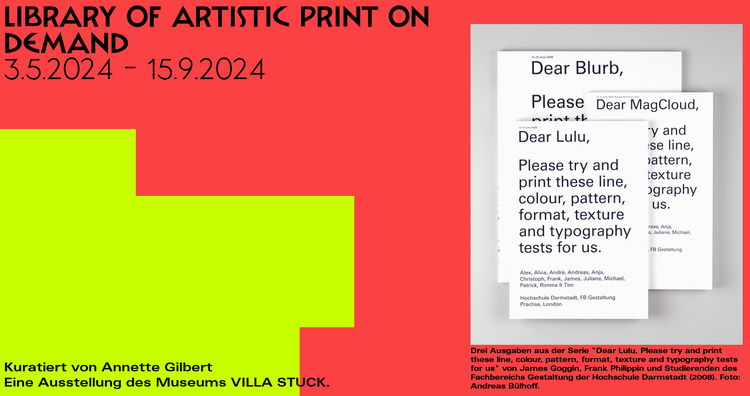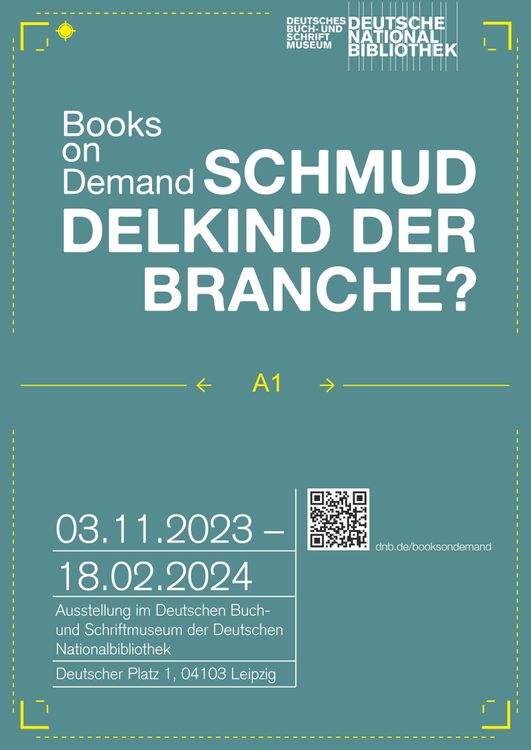Villa Stuck, Munich
from May 3, 2024 to September 15, 2024
Print on demand has revolutionized the world of books. Since the beginning of the millennium, there has been a convergence of ever better and cheaper digital printing processes and expanded possibilities offered by the global online trade. This has resulted in a production method in which books are no longer reproduced in stock. Instead, they are only printed when there is a specific need, in other words: “on demand.”
Digital platforms like Kindle Direct Publishing, Blurb, and Lulu currently dominate the on-demand production of books in the self-publishing segment. In principle, this makes it possible for anyone to publish their work immediately across the globe without having to rely on a publisher and without the need for any financial investment or risk. Just a few clicks are needed to create the books and enter them into the global book trade. This opens up space beyond the classical book market and helps democratize production. But while print on demand overturns old value attributions and bypasses gatekeepers, it at the same time creates new dependencies on digital platforms and their specifications and interests.
People also lament the loss of content quality when anyone can print anything. Moreover, digital printing and binding are often not of a high quality and the error rate in fully automated production is quite significant. On the other hand, print-on-demand platforms enable participation and experimentation and open books up to new fields of application and areas of thought. This dynamic has given rise to an entire subculture in artistic publishing that freshly explores the medium of the book in search of possible content, aesthetics, materiality, economies, and publics, while at the same time negotiating and critically reflecting on our digital present.
The books show how these innovative methods of production and publication can be harnessed creatively, used exploratively, and made subject to nuanced reflection. They also demonstrate the undiminished appeal and relevance of the printed book.
With 244 items, the “Library of Artistic Print on Demand” maps this experimental field for the first time, exploring its global spread, historical depth, and political relevance. All publications are documented extensively in a web archive.
The show includes works by
0x0a, Åbäke, ABC (Artists’ Books Cooperative), Hartmut Abendschein, Greg Allen, AND Publishing, Anonymous, Hannes Bajohr, Nanni Balestrini, Hester Barnard, Fred Benenson, Olivier Bertrand, Christian Bök, Mimi Cabell, Étienne Candel, Francesca Capone, Giulia Ciliberto, Paolo Cirio, Albert Coers, Felipe Cussen, Kris De Decker, Alexia de Visscher, Eric Doeringer, Karen ann Donnachie, Geraint Edwards, Jasper Otto Eisenecker, Ben Fry, Gauss PDF, Angela Genusa, James Goggin, Mishka Henner, Elaine W. Ho, David Horvitz, Jason Huff, Intern, Jason Jadick, Marina Kampka, Jean Keller, Dagmara Kraus, Paul Laidler, Maxime Le Bon, Joyce S. Lee, Silvio Lorusso, Nicolas Maigret, Michael Mandiberg, Michael Maranda, Holly Melgard, Luca Messarra, Joseph Mosconi, NUPoD2017 Collective, Julian Palacz, Beatrix Pang, Kathrin Passig, Frank Philippin, Michalis Pichler, Vanessa Place, Jake Reber, Aaron A. Reed, Maria Roszkowska, paula roush, Rafaël Rozendaal, Zoë Sadokierski, Joachim Schmid, Sebastian Schmieg, Andy Simionato, Danny Snelson, Paul Soulellis, Mark Staniforth, Students of the faculty of Design at the University of Applied Sciences Darmstadt, Isabelle Sully, Surfaces Utiles, Stephanie Syjuco, Chris Sylvester, Kyndal Thomas, Elisabeth Tonnard, Troll Thread, Ubermorgen, Undocumented Press, Stéphanie Vilayphiou, Angie Waller, Thomas Walskaar, Barron Webster, Gregor Weichbrodt, Yin Yin Wong, Joey Yearous-Algozin, Hermann Zschiegner, and Erin Zwaska.







